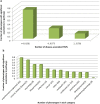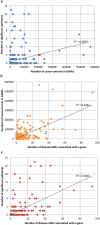Large scale analysis of phenotype-pathway relationships based on GWAS results
- PMID: 25007247
- PMCID: PMC4090199
- DOI: 10.1371/journal.pone.0100887
Large scale analysis of phenotype-pathway relationships based on GWAS results
Abstract
The widely used pathway-based approach for interpreting Genome Wide Association Studies (GWAS), assumes that since function is executed through the interactions of multiple genes, different perturbations of the same pathway would result in a similar phenotype. This assumption, however, was not systemically assessed on a large scale. To determine whether SNPs associated with a given complex phenotype affect the same pathways more than expected by chance, we analyzed 368 phenotypes that were studied in >5000 GWAS. We found 216 significant phenotype-pathway associations between 70 of the phenotypes we analyzed and known pathways. We also report 391 strong phenotype-phenotype associations between phenotypes that are affected by the same pathways. While some of these associations confirm previously reported connections, others are new and could shed light on the molecular basis of these diseases. Our findings confirm that phenotype-associated SNPs cluster into pathways much more than expected by chance. However, this is true for <20% (70/368) of the phenotypes. Different types of phenotypes show markedly different tendencies: Virtually all autoimmune phenotypes show strong clustering of SNPs into pathways, while most cancers and metabolic conditions, and all electrophysiological phenotypes, could not be significantly associated with any pathway despite being significantly associated with a large number of SNPs. While this may be due to missing data, it may also suggest that these phenotypes could result only from perturbations of specific genes and not from other perturbations of the same pathway. Further analysis of pathway-associated versus gene-associated phenotypes is, therefore, needed in order to understand disease etiology and in order to promote better drug target selection.
Conflict of interest statement
Figures







Similar articles
-
Characterizing redescriptions using persistent homology to isolate genetic pathways contributing to pathogenesis.BMC Syst Biol. 2016 Jan 11;10 Suppl 1(Suppl 1):10. doi: 10.1186/s12918-015-0251-2. BMC Syst Biol. 2016. PMID: 26819062 Free PMC article.
-
A system-level pathway-phenotype association analysis using synthetic feature random forest.Genet Epidemiol. 2014 Apr;38(3):209-19. doi: 10.1002/gepi.21794. Epub 2014 Feb 17. Genet Epidemiol. 2014. PMID: 24535726 Free PMC article.
-
Integration of VDR genome wide binding and GWAS genetic variation data reveals co-occurrence of VDR and NF-κB binding that is linked to immune phenotypes.BMC Genomics. 2017 Feb 6;18(1):132. doi: 10.1186/s12864-017-3481-4. BMC Genomics. 2017. PMID: 28166722 Free PMC article.
-
A decade in psychiatric GWAS research.Mol Psychiatry. 2019 Mar;24(3):378-389. doi: 10.1038/s41380-018-0055-z. Epub 2018 Jun 25. Mol Psychiatry. 2019. PMID: 29942042 Free PMC article. Review.
-
Shared genetic etiology underlying Alzheimer's disease and type 2 diabetes.Mol Aspects Med. 2015 Jun-Oct;43-44:66-76. doi: 10.1016/j.mam.2015.06.006. Epub 2015 Jun 23. Mol Aspects Med. 2015. PMID: 26116273 Free PMC article. Review.
Cited by
-
PhenPath: a tool for characterizing biological functions underlying different phenotypes.BMC Genomics. 2019 Jul 16;20(Suppl 8):548. doi: 10.1186/s12864-019-5868-x. BMC Genomics. 2019. PMID: 31307376 Free PMC article.
-
Investigation of multi-trait associations using pathway-based analysis of GWAS summary statistics.BMC Genomics. 2019 Feb 4;20(Suppl 1):79. doi: 10.1186/s12864-018-5373-7. BMC Genomics. 2019. PMID: 30712509 Free PMC article.
-
Chromatin landscapes and genetic risk for juvenile idiopathic arthritis.Arthritis Res Ther. 2017 Mar 14;19(1):57. doi: 10.1186/s13075-017-1260-x. Arthritis Res Ther. 2017. PMID: 28288683 Free PMC article.
-
How far from the SNP may the causative genes be?Nucleic Acids Res. 2016 Jul 27;44(13):6046-54. doi: 10.1093/nar/gkw500. Epub 2016 Jun 6. Nucleic Acids Res. 2016. PMID: 27269582 Free PMC article.
-
Prioritizing single-nucleotide polymorphisms and variants associated with clinical mastitis.Adv Appl Bioinform Chem. 2017 Jun 12;10:57-64. doi: 10.2147/AABC.S123604. eCollection 2017. Adv Appl Bioinform Chem. 2017. PMID: 28652783 Free PMC article.
References
-
- Naeem H, Zimmer R, Tavakkolkhah P, Kuffner R (2012) Rigorous assessment of gene set enrichment tests. Bioinformatics. England. 1480–1486. - PubMed
Publication types
MeSH terms
LinkOut - more resources
Full Text Sources
Other Literature Sources

